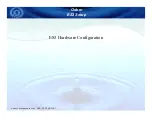
AIS CTRX GRAPHENE Class B AIS Transponder Manual
1.9E
13
CTRX GRAPHENE Manual
BEFORE YOU BEGIN THE INSTALLATION
Before you begin the installation, you should decide on where you want to place your AIS
CTRX GRAPHENE unit.
Place the transponder in in a position where you will be able to see the LED
’s on the front.
This will make it easy to monitor the functions and make sure that the unit is working
properly.
The transponder is designed to be installed were it is protected from the weather. The
transponder is NOT intended for installation outdoors or anywhere it will be exposed to direct
sunlight, moist or risk of water splashing.
The transponder should be installed in a place where the length of the antenna cables can
be kept as short as possible, but also where DC power and access to other equipment you
would want to connect the AIS to is conveniently available.
The AIS CTRX GRAPHENE has 3 external data ports. 2 of them are preferably used for the
connection to a plotter (the NMEA0183/RS422 or the NMEA 2000 port). A USB port (mini
type) is available for connection to a PC. This is used for the configuration and maintenance
of the unit.
Important when using the USB interface:
The USB port built into this product is not isolated from the vessel power supply, VHF
antenna ground or GPS antenna ground. Please observe the following procedures when
connecting the USB port to avoid grounding problems;
If the computer is permanently installed on the vessel and/ or electrically connected to any
other vessel equipment, including power supplies, it is recommended that connection is
made using NMEA0183 or NMEA2000 connections. These benefit from being specifically
designed for use in the marine environment and provide isolated and robust data transfer
between your devices.
If a battery powered laptop is being used then it is recommended to switch off the computer,
connect the USB cable and then switch on the laptop. This will help to ensure that all
equipment grounds are correctly referenced before use, minimising any risk of equipment
damage.
DC supply connection
If you are installing the AIS CTRX G version or using a Class B VHF splitter with
the standard CTRX Graphene it is recommended that you connect the DC power leads to the
same DC power connection point as your VHF.
Antennas
There are antennas available specifically made for use with AIS equipment but any standard
type marine band VHF antenna will work. The antenna gain should not exceed 0 dBd.
Place your VHF antenna as high as possible but at least 2.5-3 m above the water surface. If
you are installing a separate AIS antenna you should make sure that it is separated as much
as possible from other VHF antennas to avoid interference.
GPS antennas should be installed in such a way that the antenna top surface has a free and
unobstructed view of the horizon. Make sure that the antenna is not placed nearby metal
objects in order to minimize reflections of the received signal. GPS antennas should not be
placed in the vicinity of high power HF or satellite communications equipment.














































